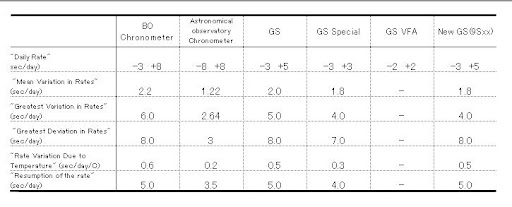I am a small watch collector who has focussed mainly on vintage Rolex. Recently, I have the urge to go into vintage Rolex watch collection owing to my love for Japan, it's culture, it's food and comics..
SEIKO, unable to compete with the high-end Swiss in the Japanese domestic market, were determined to prove that they were just as capable in producing quality watches, and were determined to do so at the Observatory Concours. After 4 years of development, SEIKO entered its movements in the contest in 1964 and secured 144th and 153rd place. For the next 3 years, the Japanese manufacture employed both of its internally-competing factories--Daini Seikosha and Suwa Seikosha--the best engineers, tremendous effort and economic resource. In 1967, SEIKO obtained 4th, 5th, 7th, 8th, and 12th place in the Chronometer Concours. In 1968, the company clenched 2nd and 3rd place. In the following year, the Observatory contests of Neuchatel were stopped, without explanation, though many speculate it was in fear of SEIKO sweeping a clear victory should the Concours continue.
It is also interesting to note that the movement calibres manufactures submitted to the Concours were specifically built for competition, and were not subsequently put into production, due to the high-precision mechanicals being not all that durable for commercial purposes. Only 2 watch companies have ever manufactured and marketed watches that passed the Observatory Chronometer trials-- Girard Perregaux and SEIKO.
The knowledge and experience that SEIKO had accumulated during the years of the Observatory Concours went into their high-grade movements. In 1966, SEIKO ceased using the “Chronometer” designation, due to the delay in setting up CICC Certification in Japan. Instead, the manufacture created a new accuracy standard, higher than the “Chronometer”. This new “AA Grade” accuracy became the “Grand Seiko (GS) Standard”. The AA Accuracy Grade was adjusted to an even tighter tolerance in 1969, to further differentiate itself from the Chronometer. Here’s a comparison table.

This is the story of the original Grand Seiko. After 24 years of absence, SEIKO launched the current generation Grand Seiko in 1998, still manufactured, assembled, adjusted and tested to SEIKO’s own internal protocol of quality and precision that are more demanding than the COSC Chronometer specifications.
First introduced in 1968, the 61GS was produced by Suwa Seikosha Co., and was the result of the feedback of technology from the astronomical observatory Concours. Developed from the base 61 SeikoMatic 5, this Grand Seiko is powered by Cal. 6145, one the best SEIKO automatic movement ever made. With 25 jewels, it oscillates at an amazing Hi-Beat 36’000 A/h, compared with 28’800 in most Swiss ETA movements, or 21’600 in most modern Seiko automatics. 61GAC complies with the revised AA Accuracy Grade with a Chronometer-crushing -3/+5 sec per day. Looking from the comparison table above, the modern GS still has not surpassed this standard.
When the 61GAC was released in 1968, it retailed at 37,000 JPY (US$410 at today’s rate, but think 1968!), and was TWICE the cost of a brand new Rolex Explorer I. The 61GS is, of course, the inspiration for the Grand Seiko SBGH001 Hi-Beat 36000, the current flagship of the Grand Seiko. MSRP in Japan is 577,500 JPY (approx. NZ$9,150).
As it has been said, watch is equipped with 6146 movement. According to article “History of Grand Seiko” by Mr. Seiya Kobayashi , this movement has been the result of technology from astronomical observatory Concours from the base 61SeikoMatic 5. There have been following variants of 61XX movement in Grand Seiko line:
- 6145 A -- GS standard official approval. 36,000bph, 25j, DATE
6146 A -- GS standard official approval. 36,000bph, 25j, DAY/DATE
6155 A -- GS Special standard official approval. 36,000bph, 25j, DATE
6156 A -- GS Special standard official approval. 36,000bph, 25j, DAY/DATE
6185 B -- VFA 36,000bph, 25j, DATE
6186 B -- VFA 36,000bph, 25j, DAY/DATE





1 comment:
Purchase your authentic brand name watch at a BIG discount on AuthenticWatches.
Post a Comment